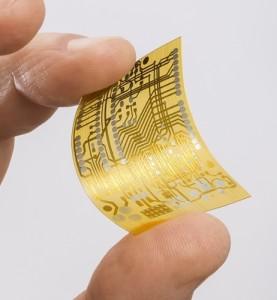 The next generation of electronics are going to be more connected than ever before thanks to the development of inexpensive materials and the Internet of Things. Everything from our homes to our televisions to our refrigerators to our toasters are all being manufactured with the capability to communicate with each other via the Internet. Many of these devices are already capable of being controlled with a smartphone or other wireless device. While smartwatches, fitness trackers and other wearable devices are commonly used these days, the ultimate goal has always been to make wearable devices invisible or as un-intrusive as possible.
The next generation of electronics are going to be more connected than ever before thanks to the development of inexpensive materials and the Internet of Things. Everything from our homes to our televisions to our refrigerators to our toasters are all being manufactured with the capability to communicate with each other via the Internet. Many of these devices are already capable of being controlled with a smartphone or other wireless device. While smartwatches, fitness trackers and other wearable devices are commonly used these days, the ultimate goal has always been to make wearable devices invisible or as un-intrusive as possible.
The most sensible way to make a wearable device undetectable is to integrate it with something that is already going to be worn by the user, like clothing. The $800 million a year smart textile industry is expected to balloon to $4.72 billion by 2020. Major sportswear and other clothing manufacturers have already developed all manner of smart fabrics that are either available on the market, or being developed for release soon. There are fabrics that help wick sweat away from the body, that will change color depending on the environment and there are even experimental fabrics that will respond to heat and open up cooling vents to prevent overheating.
But when it comes to actually integrating electronics and conductive elements into real textiles, there has been much less success. Any existing textiles with integrated electronics or conductive elements are either incredibly delicate, making them impractical for use as clothing, or end up making the fabric cumbersome and stiff. They also typically require an external battery pack, or aren’t able to be washed or treated the same way that traditional clothing is. However, thanks to 3D printing technology, textiles that can be fully integrated with electronics and sensors may be closer than ever.
This week Israeli 3D printer and 3D printed electronics manufacturer Nano Dimension announced that they have completed tests on a new process that successfully 3D printed traces of conductive materials onto textiles. The pre-treated fabric had the conductive pattern printed on it using Nano Dimension’s DragonFly 2020 3D Printer and their AgCite Silver Nanoparticle conductive ink. According to their press release, this was the result of a smart wearable textile project that they collaborated on with a leading European functional textiles company. Based on their partner’s requirements for wearable fabrics, Nano Dimension developed a process that was able to create functional electronics and sensors that were fully integrated into the textiles.
During the testing process, Nano Dimension 3D printed several different patterns onto the fabric in order to simulate real-world uses and conditions. They tested for a variety of conditions, including conductivity, elasticity, touch and rubbing. According to Nano Dimension, the results of the tests proved that their silver conductive inks were capable of matching the elasticity and material properties of the fabric. Their 3D printing technology was able to create “smart” functional fabrics that could be worn, folded and stretched without damaging or compromising the integrated electronics.
While this technology is still experimental, the tests that Nano Dimension conducted prove that their nanomaterials and 3D printing processes are capable of producing functional, smart textiles that can be used in a wide variety of applications. Textiles with integrated electronics will have military uses, as well applications in the medical industry and the personal electronics industry. Potential applications include smart bandages that can monitor patients’ vitals without cords, ultra-thin virtual reality gloves, clothing with integrated electronic devices like MP3 players and sportswear that monitors progress and manages body temperature. Discuss further in the Nano Dimension Conductive Materials forum over at 3DPB.com.
Subscribe to Our Email Newsletter
Stay up-to-date on all the latest news from the 3D printing industry and receive information and offers from third party vendors.
You May Also Like
Further Understanding of 3D Printing Design at ADDITIV Design World
ADDITIV is back once again! This time, the virtual platform for additive manufacturing will be holding the first-ever edition of ADDITIV Design World on May 23rd from 9:00 AM –...
3D Printer Maker EVO-tech Reborn as NEVO3D — Once More With Feeling
EVO-tech was a 3D printing service and original equipment manufacturer established in 2013 and based in Schörfling am Attersee, Austria. The company produced high-quality material extrusion systems featuring linear bearings,...
3D Systems Brings 3D Printed PEEK Cranial Implant to the U.S. with FDA Clearance
For more than 10 years, 3D Systems (NYSE:DDD) has worked hand-in-hand with surgeons to plan over 150,000 patient-specific cases, and develop more than two million instruments and implants from its...
CDFAM Returns to Berlin for Second Annual Symposium
The second CDFAM Computational Design Symposium is scheduled for May 7-8, 2024, in Berlin, and will convene leading experts in computational design across all scales. Building upon the first event...

































